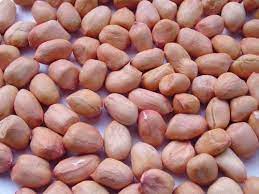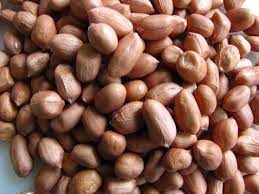Economic Importance, Uses, and By-Products of Groundnuts/Peanuts Seeds (peanuts)
Groundnuts/Peanuts Seeds (peanuts), are edible seeds that belong to the legume family, Fabaceae. They are native to South America but are now grown in many parts of the world. Peanuts are widely consumed due to their nutty flavor, crunchy texture, and various culinary uses.
Peanuts are small, oval-shaped seeds, usually measuring about 1 to 2 centimeters in length. Each peanut consists of two elongated, uneven halves contained within a thin, papery reddish-brown shell.
Shell: The shell of the peanut is called the “pod” or “hull.” It protects the seeds inside and can be easily removed to access the edible part.
The seeds themselves vary in color depending on the variety but are typically beige or pale yellow.
Roasting peanuts enhances their flavor, making them a popular snack on their own or mixed with other nuts.Crushed peanuts are commonly used to make smooth or chunky peanut butter, a beloved spread for sandwiches, crackers, and fruits.
Cooking Oil: Peanut oil is extracted from the seeds and is commonly used in cooking and frying due to its high smoke point.A popular confectionery treat made by combining peanuts with caramelized sugar.
Peanut Sauce: Peanuts are used to prepare flavorful sauces in various cuisines, such as satay sauce in Southeast Asian dishes.
They are a good source of plant-based protein, making them an excellent option for vegetarians and vegans.
Peanuts contain monounsaturated and polyunsaturated fats that are heart-healthy. They provide essential vitamins and minerals, including vitamin E, B vitamins, magnesium, phosphorus, and potassium.
Overall, peanuts are a popular and nutritious food enjoyed in various culinary traditions around the world.
Economic Importance, Uses, and By-Products of Groundnuts/Peanuts Seeds (peanuts)

Groundnuts, also known as peanuts, are economically important seeds with a wide range of uses. They are cultivated in many countries around the world and play a crucial role in the global economy. Here are some of the economic importance and uses of groundnuts:
1. Food Industry: Groundnuts are widely used in the food industry for various purposes. They can be consumed in raw, roasted, or processed forms, and they serve as a popular snack. Groundnut butter (peanut butter) is a widely consumed product that is used as a spread, ingredient in various recipes, and a protein-rich addition to diets. Peanut oil is another significant product extracted from groundnuts and is used for cooking, frying, and as an ingredient in various food products.
2. Animal Feed: Groundnut seeds and their by-products, such as groundnut cake (residue after oil extraction), are valuable sources of protein and nutrients for livestock feed. The leftover cake from oil extraction is used as animal feed, contributing to the livestock industry.
3. Oil Extraction: Groundnuts are an important source of oil, which is extracted through various processes like cold pressing or solvent extraction. Peanut oil is used for cooking, salad dressings, and in the production of margarine and other food products.
4. Confectionery and Snack Industry: Groundnuts are used in the confectionery industry to produce candies, chocolates, and other sweets. Additionally, roasted and flavored groundnuts are popular as snacks.
5. Culinary Uses: Groundnuts are widely used as an ingredient in various culinary dishes, especially in Asian and African cuisines. They are used in sauces, soups, stews, curries, and various vegetable and meat dishes.
Read Also : Economic Importance, Uses, and By-Products of Groundnuts/Peanuts Leaves
6. Pharmaceutical Industry: Groundnuts contain valuable compounds such as resveratrol, phytosterols, and antioxidants, making them beneficial for health. These compounds have potential applications in the pharmaceutical industry for various medicinal purposes.
7. Industrial Uses: Groundnut shells and husks have industrial applications, including as fuel for boilers and in the production of activated carbon.
8. Groundnut Flour: Groundnut flour is made by grinding roasted or blanched groundnuts and has various applications in baking and cooking. It is used to make gluten-free baked goods, bread, and desserts.
9. Groundnut Milk: Groundnut milk, similar to almond milk, can be made by blending groundnuts with water and straining. It is used as a dairy alternative and as a base for smoothies and other beverages.
10. Biodiesel Production: Groundnut oil can be used as a feedstock for biodiesel production. Biodiesel is a renewable and eco-friendly alternative to conventional diesel fuel. By utilizing groundnut oil for biodiesel production, it reduces the dependence on fossil fuels and helps in mitigating greenhouse gas emissions.
11. Soil Improvement: Groundnuts are leguminous plants, which means they have the ability to fix atmospheric nitrogen into the soil through a symbiotic relationship with nitrogen-fixing bacteria. This process enhances soil fertility and reduces the need for synthetic nitrogen fertilizers. Farmers often use groundnuts in crop rotation systems to improve soil health and productivity.
12. Employment and Income Generation: Groundnut cultivation and processing provide employment opportunities to millions of people worldwide. From farmers and agricultural laborers involved in cultivation to workers in processing units, transportation, and marketing, the groundnut industry supports a significant portion of the population, especially in rural areas.
13. Export Revenue: Groundnuts are a major agricultural export commodity for many countries. Exporting groundnut products, such as groundnut oil, peanut butter, and snacks, generates foreign exchange and boosts the economy by promoting international trade.
14. By-Product Utilization: Groundnut shells and husks, which are by-products of the oil extraction process, have various uses. They can be used as a source of energy through combustion, as well as in the production of fertilizers and animal feed.
15. Groundnut Processing Industry: The groundnut processing industry encompasses a wide range of activities, including shelling, roasting, blanching, oil extraction, and manufacturing various groundnut-based products. This industry generates substantial revenue and job opportunities in both developed and developing economies.
Example:
In countries like the United States, where groundnut production is significant, it has become an essential component of the agricultural sector. The states of Georgia, Texas, Alabama, and Florida are major groundnut-producing regions. Groundnuts are processed into various products like peanut butter, peanut oil, and snacks. The surplus production is exported to countries with high demand, creating substantial export revenue for the country.
In developing countries like Nigeria and India, groundnut cultivation is an important source of income for smallholder farmers. Groundnut processing units, especially oil extraction mills, are widespread, creating opportunities for entrepreneurs and employment for localcommunities.
In conclusion, groundnuts have a multitude of economic uses that extend beyond their culinary value. From providing food and animal feed to supporting industries like oil extraction, confectionery, and pharmaceuticals, groundnuts play a crucial role in the global economy. Additionally, their contribution to soil improvement, employment generation, and export revenue make them an economically vital crop for many nations.
The Products and By-products That Can Be Derived From Groundnuts/Peanuts Seeds (peanuts)

Groundnuts, also known as peanuts, are a versatile crop that can yield various products and by-products. Below are some of the main products and by-products that can be derived from groundnut seeds, along with brief explanations, examples, and processes:
1. Peanut Oil: Peanut oil is a popular cooking oil known for its mild flavor and high smoke point.
Example: Refined peanut oil used for frying and cooking.
Process: The groundnut seeds are cleaned, shelled, and then pressed to extract the oil. This oil is then refined to remove impurities.
2. Peanut Butter: Peanut butter is a creamy spread made from roasted peanuts.
Example: Creamy or crunchy peanut butter varieties.
Process: Roasted peanuts are ground to a smooth or chunky consistency, and optional ingredients like salt, sweeteners, or stabilizers may be added.
3. Peanut Flour: Peanut flour is a protein-rich flour made from defatted groundnuts.
Example: Used in baked goods, sauces, and as a thickening agent in recipes.
Process: After extracting oil from groundnuts, the remaining cake is ground into a fine powder, resulting in peanut flour.
4. Peanut Meal/Cake: Peanut meal, also known as cake, is a by-product obtained after oil extraction.
Example: Used as animal feed or in organic farming as a natural fertilizer.
Process: Groundnut seeds are pressed to extract oil, and the remaining solid material is processed into meal or cake.
5. Peanut Husks: Peanut husks are the outer shell of the groundnut seeds.
Example: Can be used as animal bedding, mulch, or biofuel.
Process: The shells are separated from the seeds during the shelling process.
6. Peanut Shell Briquettes: Peanut shell briquettes are a form of biofuel made from peanut shells.
Example: Used as an eco-friendly alternative to charcoal or firewood for cooking.
Process: Peanut shells are compacted into briquettes without the need for binders.
7. Peanut Protein Isolate: Peanut protein isolate is a concentrated form of protein extracted from groundnuts.
Example: Used in protein bars, shakes, and supplements.
Read Also : Economic Importance, Uses, and By-Products of Groundnuts/Peanuts Shells
Process: Groundnuts undergo various extraction and purification processes to obtain the isolated protein.
8. Peanut Milk: Peanut milk is a non-dairy milk alternative made from groundnuts.
Example: Suitable for those with lactose intolerance or following a vegan diet.
Process: Groundnuts are soaked, blended, and then strained to obtain a milky liquid.
9. Peanut Snacks: Various snacks like roasted peanuts, peanut brittle, and flavored peanuts.
Example: Roasted salted peanuts, honey-roasted peanuts, peanut brittle, etc.
Process: Peanuts are roasted, seasoned, or processed into various snack forms.
10. Peanut Candy: Peanut candy is a confection made from groundnuts and sweeteners.
Example: Examples include peanut chikki (an Indian sweet snack) and peanut clusters.
Process: Groundnuts are mixed with sugar or jaggery (a type of unrefined sugar) and then molded into candy shapes.
11. Peanut Vinegar: Peanut vinegar is a type of vinegar made from fermented groundnuts.
Example: Used in various culinary applications, such as salad dressings or marinades.
Process: Groundnuts are fermented to produce alcohol, which is then converted into vinegar through acetic acid fermentation.
12. Peanut Soap: Peanut soap is soap made with peanut oil or peanut meal.
Example: Natural, handmade soap often used for its moisturizing properties.
Process: Peanut oil or peanut meal is incorporated into soap-making processes to create peanut soap.
13. Peanut Shells for Mushroom Cultivation: Peanut shells can be used as a substrate for growing certain types of mushrooms.
Example: Commonly used for growing oyster mushrooms.
Process: Peanut shells are treated and sterilized before being inoculated with mushroom spores.
14. Peanut Fuel Pellets: Peanut shells can be compressed into fuel pellets for biomass energy.
Example: Used in stoves, furnaces, and boilers for heating purposes.
Process: Peanut shells are compressed into pellet form without additives or binders.
15. Peanut Dye: Peanut shells can be used to create a natural dye.
Example: The dye can be used for coloring textiles or other materials.
Process: Peanut shells are boiled to extract the color pigments, which can then be used as a dye.
16. Peanut Starch: Peanut starch is a by-product obtained during peanut oil extraction.
Example: Used in the food industry as a thickening agent or stabilizer.
Process: Starch is separated from the groundnut cake or meal after oil extraction.
17. Peanut Silage: Peanut plants can be used to make silage for livestock feed.
Example: Feed for cattle and other ruminants.
Process: Peanut plants are harvested, chopped, and ensiled for fermentation.
These are examples of products and by-products derived from groundnuts. As you can see, groundnuts offer a wide range of uses across various industries, from food and agriculture to alternative energy and crafting. Their utilization helps reduce waste and maximizes the economic and environmental benefits of this valuable crop.
Read Also : Importance Of Farm Fencing









